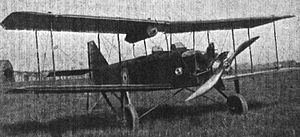Top speed 145 km/h Length 6.91 m Designer Robert B.C. Noorduyn | Wingspan 7.62 m Manufacturer British Aerial Transport | |
 | ||
The BAT F.K.24 Baboon was a British two-seat training biplane produced by British Aerial Transport Company Limited of London during World War I.
Contents
Design and development
Using experience gained designing the Bantam, aircraft designer Frederick Koolhoven (assisted by Robert Noorduyn) designed an elementary trainer, a two-bay biplane known as the F.K.24 Baboon. The aircraft had a flat-sided fuselage and an uncowled 170 hp (127 kW) ABC Wasp engine. Six aircraft were planned but only one was built in July 1918. The only notable act was when it won the Hendon Trophy Race over a 20-mile (32-km) circuit in July 1919 flown by Christopher Draper. The Baboon was scrapped in 1920.
Specifications (F.K.24 Baboon)
Data from British Aeroplanes 1914-18
General characteristics
Performance
References
BAT Baboon Wikipedia(Text) CC BY-SA
